
Elizabeth, going native
This seemed a good time to visit the Middle East. So we went to Philadelphia. That was the ancient Greek name. Before that, Rabboth-Ammon; thus, today, Amman.
The country is named for the River Jordan – the river of metaphor – “I’m only going up over Jordan” – The Ur-River – “Michael, row the boat ashore.” Would’ve been nice to see it. We didn’t.
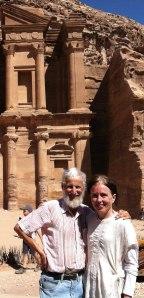
Therese and me at Petra
The “we” included my ever cheerful ace travel partner Therese. Up at 5:30 and out the door at 5:40? Sure, no problem.
We were visiting our daughter Elizabeth, 21, living in Amman studying Arabic. Having an Eid holiday break, she organized a tour for us. English speakers being rare, it was great having Elizabeth as our Arabic-speaking guide; especially negotiating with cab drivers. (It’s a point of honor for Elizabeth not to overpay.)
She is also studying the economy of the Zaatari refugee camp, near Amman, a reminder that conflict is not far away. And working with Questscope, an NGO, developing a “youth empowerment” program. Amman is full of seemingly unoccupied young men – potential jihadist recruits. Elizabeth’s project aims to give them better outlets for their energies.
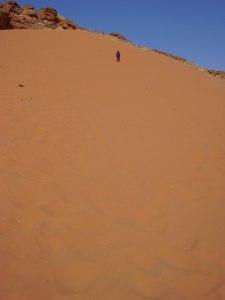
Therese climbs a sand dune at Wadi Rum
Historical context: In 1948, the UN partitioned the British-run Palestine territory, creating Israel and an Arab state – Jordan. Israel, in the 1967 war, took a big piece of Jordan – the West Bank. (In the national museum a large map labeled all the surrounding nations; Israel (including the West Bank) was called “Palestine.”)
Monarchy is not my favorite system, but Jordan been blessed with unusually enlightened monarchs. After the ’67 war, King Hussein did something astoundingly smart – renounced all claim to the West Bank. So Jordan could get on with life, not wasting its energies in futile irredentism. (Palestinians take note.)
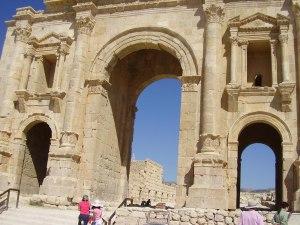
Jerash
In Amman we joined up with one of Elizabeth’s Questscope pals for a car trip to Jerash. Along the way we saw many roadside pens with sheep and goats, often with a skinned carcass dangling from a scaffold, apparently for sale for Eid holiday feasting. One also continually saw little cubical concrete or cinderblock structures, some utilized for storage or mini-stores, but more often rubbish strewn, never completed, or half ruined. Aborted construction seemed ubiquitous. Also used tires – sometimes arranged in decorative megaliths.
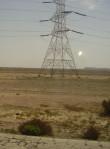
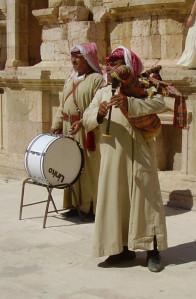
Jerash was ancient Gerasa. (In Roman times, the area, including Philadelphia, was called Decapolis, part of Syria.) The ruins are well preserved. In the amphitheater, two guys in full Arab regalia performed rousing Scottish (!) music on drums and bagpipes. I told my wife, “Here’s what we missed with no Scottish independence celebration to go to!”
Amid the ruins, a local fellow latched on to us and helpfully pointed out various details. Of course I knew he expected a tip, but was taken aback when he insisted on 30 Dinars (while repeating, “I’m a Muslim”). I wound up giving him 20 Dinars ($28), and though he feigned displeasure, it was wildly excessive. Well, it was our first day.
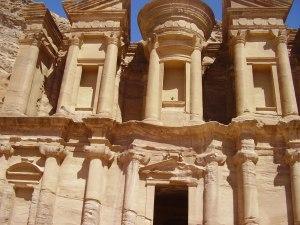
Petra
Then we took a bus to Petra, the amazing capital of the Nabataeans (flourished in the first centuries BC and AD). Access is through a long, very narrow, deep gorge; the city’s main features were mostly carved right out of the rock. We had to climb for hours, a more strenuous challenge than I’ve had in years; but my 67 year old carcass managed it.
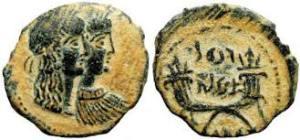
Nabataean coin
Nabataean coins are very cool and I’d have liked to find some nice ones. Many tchotchke sellers there did have coins – garishly made to look like what a tourist might imagine for ancient coins. When one guy pressed his fakes at me and I laughed them off, he asked if I would recognize real ones. Then he showed me two coins – one, an Aelius denarius (rare), at least a realistic fake, the other a little bronze, genuine but miserable and worthless.
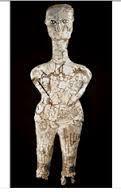
At Petra, Elizabeth asked a guy at the visitor center what we should expect to pay for a taxi to Wadi Rum. Not only did he find an answer, he made some calls and arranged the ride, for a price at the bottom of the range. Such helpfulness is something we’ve found throughout our many travels (except of course in France). The Jordanians were lovely, save only for one kid who threw garbage at us, shouting “haram!” (“Non-kosher”)
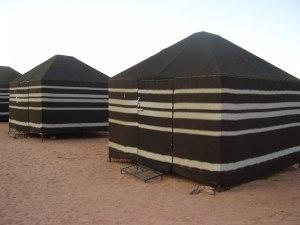
Our deluxe accommodations at Wadi Rum
That taxi trip – an hour and three quarters – cost all of 30 Dinars ($42; made me wince again at what I’d given the “guide” at Jerash). The car radio was tuned to a Russian talk show. I asked the driver if he spoke Russian. He said no.
Wadi Rum was our desert “Bedouin camp” experience. Well, it was no tarted-up dude ranch. The guys in Arab dress lounging and conversing around the camp fire looked like they came out of some old picture book.
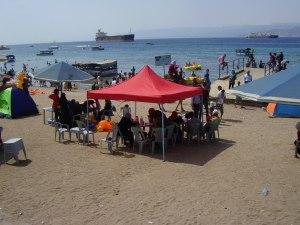
Aqaba. Can you spot the camel?
Next, like Lawrence and his 1917 Arab rebels we marched on camelback across the forbidding Nefud desert to Aqaba. Actually, we took another taxi (one hour; 25 Dinars; but the guy had to drive to Wadi Rum from Aqaba to get us). Aqaba has become a major seaside resort town.
We took another bus back to Amman. Midway there was a smoking break, when almost everyone got off to puff.
Amman’s main art museum (privately funded) was eye-opening – contemporary art from developing nations, nearly all Muslim. Not ethnic ghetto stuff, but interesting and accomplished work at the highest level. But ordinarily we never see it, not even at the international art fair we recently attended in Dubai. Yet another aspect of how the Muslim world is cut off from the wider global culture.
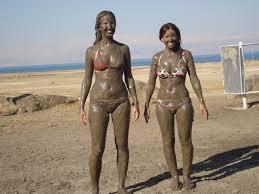
Jordan is a good country. If ISIS attacks it, mine had better be there. With boots on the ground.
